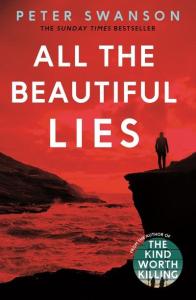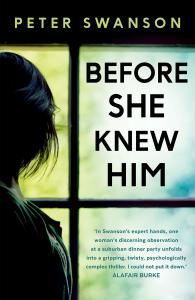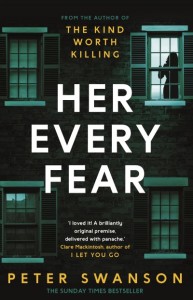All the Beautiful Lies – Peter Swanson
 ‘All the Beautiful Lies’ is the third novel by US author Peter Swanson I’ve had the pleasure of reading and reviewing, after ‘The Kind Worth Killing’ and ‘Her Every Fear’, and the fourth he published since 2014, when his debut novel ‘The Girl With a Clock for a Heart’ was nominated for the LA Times book award.
‘All the Beautiful Lies’ is the third novel by US author Peter Swanson I’ve had the pleasure of reading and reviewing, after ‘The Kind Worth Killing’ and ‘Her Every Fear’, and the fourth he published since 2014, when his debut novel ‘The Girl With a Clock for a Heart’ was nominated for the LA Times book award.
Swanson’s novels are stand-alone stories, a choice which makes them stand out in contemporary crime and thriller literature, where series abound. But they also stand in a class of their own as psychological suspense novels, thanks to their atmosphere and characterisation, and ‘All the Beautiful Lies’ is no exception.
The story is built around four main characters, and it shifts between a contemporary ‘now’ and a ‘then of about twenty years ago. Less than a week before university graduation, Harry Ackerson learns his father Bill, who owns a rare books shop in Kennewick, a small town in Maine, has died suddenly in what looks like a hiking accident. Harry rushes back to the sprawling house his father inhabited with Harry’s stepmother Alice, Bill’s second wife, who is only some fifteen years older than Harry. Alice is inconsolable but oddly unreadable, a strange, ephemeral presence adding to the mystery of Bill’s death, about which precious few facts are known.
It’s a low-key beginning, yet one that is full of foreboding and unspoken possibilities, as Swanson’s spare, sharply defined prose sketches the peculiar relationship between Harry and Alice. They met only occasionally before the tragedy, since Bill and Alice got together after Harry started college, and as a result there is an awkwardness in how son and wife deal with their bereavement. They both appear self-contained, almost shy, though the unusually small age difference between the college youngster and his father’s second wife adds a special frisson to the immediate aftermath of Bill’s death.
Flash back to Alice’s early teen age, when she moved with her single mother Edith to Kennewick. Theirs is a very ordinary life as newcomers to a sleepy holiday resort. Alice has troubles fitting in at school, as any teenager, and a fairly reserved one to boot, would in a small town, and Edith doesn’t do much to brighten up her daughter’s life, though she befriends an investment consultant at a bank in a nearby town, Jake Richter, a slightly older single man whom she soon marries.
Swanson seems to play a cat-and-mouse game with his readers. He creates suspense mostly by accrual, his deft writing slowly adding elements that spice up the story. He makes you wonder what kind of life Bill and his much younger wife had, and whether there is an attraction between Harry and Alice, something which could perhaps constitute a motive for killing Bill. Though no sinister reason is immediately apparent, Bill’s fall off a cliff which was set apart from the path he was walking on is so hard to explain that, as a reader, you cannot help but wonder.
And wonder is what Swanson will gladly help you to do. He gradually adds details and layers of meaning with impeccable narrative timing, introducing another woman into the plot, Grace, a young New Yorker pretty much Harry’s age who shows up unaccountably in Kennewick after Bill’s death, and even attends Bill’s funeral. Harry is intrigued and soon learns that Grace and his father Bill knew each other from the time when Bill run another rare books shop, in Manhattan. There is some chemistry between Harry and Grace, or at least the beginning of. Before Grace can explain to Harry the full extent of her relationship with Bill however, she is brutally murdered in the short-let apartment she was living in in Kennewick.
This is where I must stop telling about the plot, to avoid any spoiler. Something it’s hard to do when reviewing Swanson, whose novels are thinner than other thrillers plotwise, as they rely much more on nuances, on the unsaid and what can only be guessed at as much as on what characters do and think and say. Not there isn’t meat to the story: I have not dwelled for example on the other major element in the plot, the part about Alice’s teenage years, including her mother’s tragic death and Alice’s relationship with her stepfather Jake, a part which gradually paints a picture of a very disturbing young woman.
As Swanson’s previous novels have, ‘All the Beautiful Lies’ has a very rich texture which the reader gets to see only gradually, so cleverly it is disguised. It is painstaking work by Swanson: I can imagine him chiselling at the rough outline of his work, peeling away all that’s superfluous and chipping out the unnecessary, leaving enough kinks in the work so that some parts of it are initially hidden from the readers’ view, only to be revealed by a sudden, small shift in perspective.
Swanson is supremely good at doing this, though pure whodunnit aficionados might wish there were more characters behind whom Swanson could hide his or her villain, making for a more surprising denouement. On the other hand, having a relatively small cast is what enables Swanson to build atmosphere and suspense. He takes his time in fleshing out the lives of Alice, Jake, Bill and Harry, making them come alive as multi-dimensional characters, and not merely props for a plot, crafting an intriguing, gripping novel.
As he did notably in ‘Her Every Fear’, Swanson shies away from super heroes, action characters and clever investigators. ‘All the Beautiful Lies’ is very much about a crime, in fact more than one, but only police procedural diehards would I think lament the absence of a dominating investigator figure. With Swanson, the focus is more on intentions than results, more on psychology than action. Yet, despite the absence of these classic elements, his novels are viciously gripping.
I think the mark of a good author is how much he or she is able to make readers trust them, letting the readers be drawn into the narrative without the urge to skip forward or, worse, stop reading. Above all, in getting readers to believe in the characters and want to know what makes them tick. As ‘All the Beautiful Lies’ confirms, Swanson is very good at this game, at building up a rhythm, at adding the right amount of twists to keep readers guessing, and at making his characters real people within a mesmerising fictional world.






